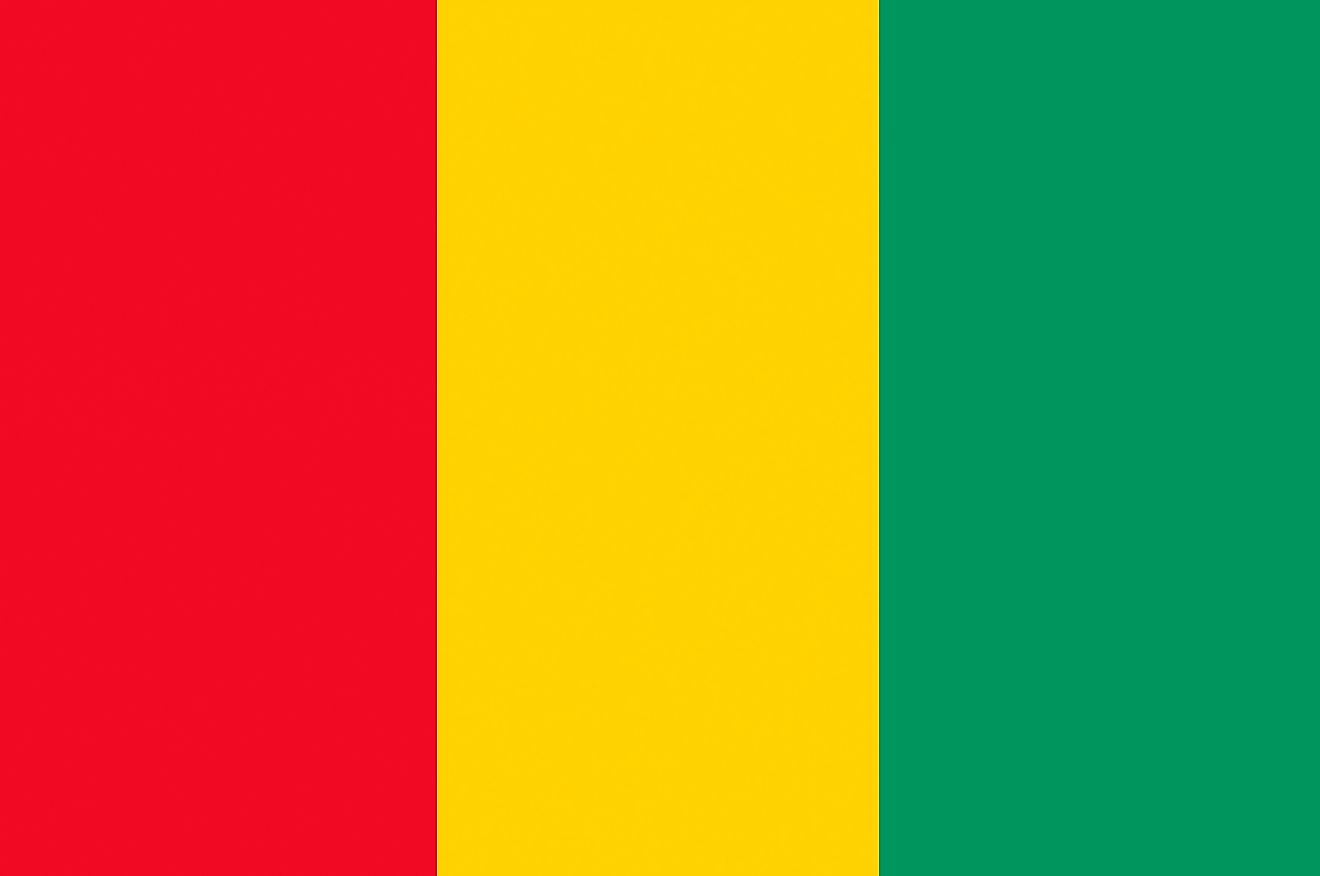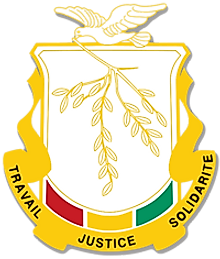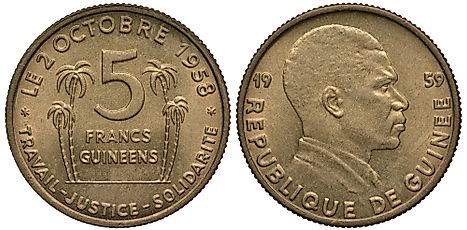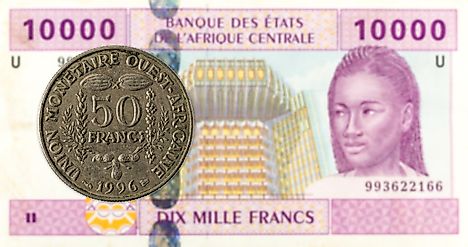Flags, Symbols, & Currencies of Guinea

The national flag of Guinea was officially adopted on November 10, 1958. The flag is based on the pan-African colors of red, yellow, and green, and closely resembles the Ghanain flag. Unlike the Ghanaian flag, which features three horizontal bands with a black star, the flag of Guinea consists of three equal vertical bands of red (hoist side), yellow, and green. The flag's colors from left to right (green, yellow, and red) forms the flag of Mali
The colors of the flag of Guinea have the same meaning as those on the flag of Ghana. The red color represents the people's sacrifice for liberation or struggle for independence or blood of those who died in slavery or war. The yellow stands for the sun, the riches of the earth, and for justice. The green color symbolizes the country's vegetation and unity
Symbols of Guinea
National Coat of Arms of Guinea

The coat of arms of Guinea was adopted in 1993 and is composed of a dove carrying a golden olive branch in its beak, as well as a ribbon displaying the national motto: Travail, Justice, Solidarite (Work, Justice, Solidarity). Inside the shield are the three colors of Guinean national flag: red, yellow, and gree. The coat of arms adopted in 1958 featured a red and green shield with a golden elephant in the middle. The dove carrying green olive branch flew over the shield.
National Anthem
- Anthem Title: Liberté (Freedom)
- Music composer: Fodéba Keïta
- Lyricist: Unknown
- Date of Adoption: 1958
The national anthem of Guinea, known as Liberté, was adopted in 1958 as the country's official anthem. Although the lyric's author is not known, the music was composed and arranged by Fodéba Keïta.
Liberté
Peuple d'Afrique,
Le Passé historique !
Que chante l'hymne de la Guinée fière et jeune
Illustre épopée de nos frères
Morts au champ d'honneur en libérant l'Afrique !
Le peuple de Guinée prêchant l'unité
Appelle l'Afrique.
Liberté! C'est la voix d'un peuple
Qui appelle tous ses frères de la grande Afrique.
Liberté! C'est la voix d'un peuple
Qui appelle tous ses frères à se retrouver.
Bâtissons l'unité africaine dans l'indépendance retrouvée.
Freedom
People of Africa!
The historic past!
Sing the hymn of a Guinea proud and young
Illustrious epic of our brothers
Who died on the field of honour while liberating Africa!
The people of Guinea, preaching Unity,
Call to Africa.
Liberty! The voice of a people
Who call all her brothers of a great Africa.
Liberty! The voice of a people
Who call all her brothers to find their way again.
Let us build African Unity in a newly found independence!
The Currency of Guinea is the Guinean franc
The official currency used in Guinea is the Guinean franc. It is subdivided into 100 portions called centimes. The symbol used to represent it is (FG or GFr).
Banknotes and Coins
Although the next production of banknotes was released in 1963, the notes were dated March 1st, 1960. The series of banknotes was similar to the previous series except there was the exclusion of the 10,000 franc note. The series also lacked the imprint of Thomas Delarue and was modeled in different colors with more security features such as complex advanced embossing. The country used the franc until 1971 when it was substituted by the syli, with one syli being equivalent to 10 francs.
In 1985, the Guinean franc was recirculated as Guinean currency together with the syli. The coins were circulated in the denominations of 1, 5, and 10 francs and were minted from brass with an overcoat of steel. Later in 1994, the cupronickel 50 francs was included in the denomination. The banknotes were produced in denominations of 25, 50, 100, 500, 1,000, and 5,000. There is a big difference comparing Guinean notes of this series with those of the other countries. The date of issue is represented uniquely at the left-hand corner of each banknote
The 25 and 50 franc notes were excluded from circulation in 1998 after being substituted by coins. Another denomination was produced in 2006 and consisted of 500, 1,000, and 5,000 francs in resemblance to the previous notes. More security features were added to these notes and the size of the 500 franc was minimized. A 10,000 franc note was later produced and adopted on June 11th, 2007.
Historical Currencies of Guinea
Guinea used the CFA franc until 1959 when the Guinean franc was introduced. The coins were minted from bronze and were circulated in denominations of 1, 5, 10, and 25. The bank notes were issued in 1958 and were circulated in denominations of 50, 100, 5,000, and 10,000 franc currency.













